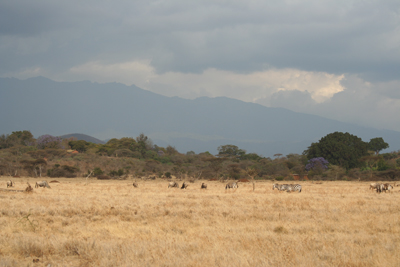Kilimanjaro: Day 3
Sunday: Day of rest?
| Night stop: | Ndarakwai Ranch |
| Elevation: | 4,200 ft |
| Gain: | 1,270 ft |
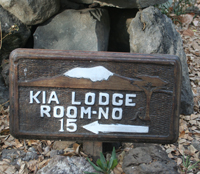
This way...
..or that way, or... In the end a maid led us there. But the wood carving of the mountain is cute.
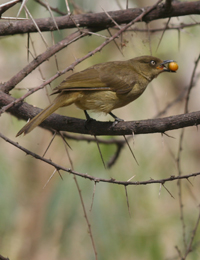
Zanzibar Sombre Greenbul
...
After a breakfast of coffee, made-to-order omelets, fried potatoes, beans, coffee, pastries, fruit juice, more coffee and deliciously sweet mini bananas, we were called to order by the head guides for the grandly titled “Climb Briefing.” We will be briefed. And we will be supplied with any rental equipment we have booked. There will be two teams, which is why there are so many of us.
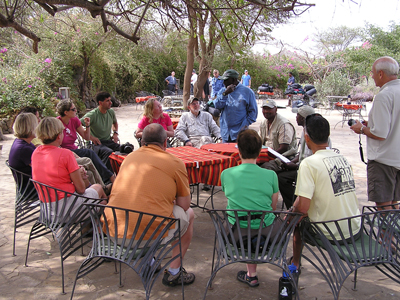 Photo courtesy and Copyright © 2010 Wayne R Munns
Photo courtesy and Copyright © 2010 Wayne R Munns
As the teams settled at their respective tables, I was disappointed to see that all the ladies had been assigned to the other team. What’s up with that? We can’t be trusted with the (eye) candy? To add insult to injury, our monica is to be tembo (elephant) while theirs is simba (lion). Good grief. The ladies must have fixed that too.
I have no idea what we were looking for, but we all eye each other looking for signs of something or other. Guiltily, I suspect it is for signs of weakness—who is not going to make it? But in the close conditions we are expecting over the next week, I for one was also looking for signs of anyone I might have to kill before we got there. I saw no obvious candidates for either situation, though the jury was not exactly unanimous. The eleven guys who are gathered at our table are 23 to 67, with a heavy emphasis towards the right hand end of that range. The head guide introduces himself. "I am Andrew David Kitema. Write that down. I am going to lead you to the roof of Africa."
"Who is using Diamox?" Wow—first question? We all raise our hands. Double wow. All of us? Here is a less-than comforting note Wayne found on the interweb during our usual pre-trip research phase: "The main point of instructing travelers about altitude illness is not to prevent any possibility of altitude illness, but to prevent death from altitude illness." Death? Well, that got our attention. Further digging. There were plenty of mixed messages about effectiveness of "cures," when to start taking drugs, and (huge variations in) recommended dosage, hence my surprise at the team's unanimous conclusion, but the following seems fairly undisputed.
This morning you will have a climb briefing at KIA lodge before transferring to your base camp on the west side of Kilimanjaro. The camp is set in under the spreading branches of Acacia tortillis nestled near a volcanic cone which affords superb sunset views. This day also serves as an acclimatization day and a day to recover from the long flights.
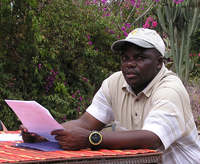
Andrew David Kitema
Head guide and all around first-class human being.
There are three (and only three) definitions of high altitude: High Altitude; Very High Altitude; and Extreme Altitude (above 5,500m). Kilimanjaro is in with the big boys in that it is an extreme high altitude mountain. (See this chart for comparisons.) As you ascend, your body acclimatizes to the decreasing oxygen (hypoxia). At any moment, there is an "ideal" altitude where your body is in balance; most likely this is the last elevation at which you slept. Extending above this is a gray zone where your body can tolerate the lower oxygen levels, but to which you are not quite acclimatized. If you get above the upper limit of this zone, there is not enough oxygen for your body to function properly, and symptoms of hypoxic distress occur—this is Acute Mountain Sickness (AMS). AMS is the most common form of altitude illness. Like a hangover, headache is the chief symptom, sometimes accompanied by fatigue, loss of appetite, nausea, and, occasionally, vomiting.
AMS symptoms resolve very rapidly (minutes) on moderate-flow oxygen. In most high altitude environments, oxygen is a precious commodity. For trekking groups and expeditions going into remote high-altitude areas, where descent to a lower altitude could be problematic, a pressurization bag (such as the Gamow bag) can prove extremely beneficial. Pay attention, this will be important later. Don't panic, it's not that important.
The human body adjusts very well to moderate hypoxia, but requires time to do so. The process of acute acclimatization to high altitude takes 3-5 days; therefore, acclimatizing for a few days at 8,000-9,000ft before proceeding to higher altitude is ideal. Increase in ventilation is the most important factor in acute acclimatization. But as Wayne pointed out, increased red-cell production does not play a role in acute acclimatization. Go too high above what you are prepared for, and you get sick. This "zone of tolerance" moves up with you as you acclimatize to a higher elevation, and thus your zone of tolerance extends that much higher up the mountain. The trick is to limit your daily upward travel to stay within that tolerance zone.
But we're not done yet. Persistent increased breathing results in reduction of carbon dioxide in the blood, a metabolic waste product that is removed by the lungs. The build-up of carbon dioxide in the blood is the key signal to the brain that it is time to breathe, so if it is low, the drive to breathe is blunted (the lack of oxygen is a much weaker signal, and acts as an ultimate safety valve). As long as you are awake it isn't much trouble to consciously breathe, but at night an odd breathing pattern develops due to a back-and-forth balancing act between these two respiratory triggers. Periodic breathing consists of cycles of normal breathing which gradually slows, breath-holding, and a brief recovery period of accelerated breathing. This is called Cheyne-Stokes respiration. The breath-holding may last up to 10-15 seconds. This is not altitude sickness. It may improve slightly with acclimatization, but does not usually resolve until descent. Periodic breathing can cause a lot of anxiety:
- In the person who wakes up during the breath-holding phase and knows he has stopped breathing.
- In the person who wakes up in the post-breath-holding hyperventilation (recovery) phase and thinks he's short of breath and has High Altitude Pulmonary Edema (HAPE).
- In the person who wakes up and realizes his neighbor has stopped breathing.
In the first two cases waiting a few moments will establish a normal breathing pattern. In the final case, the sleeping neighbor will eventually take a breath, though periodic breathing cycles will likely continue until he or she is awake. When my daughter was six weeks old, I woke up in the middle of the night to discover she was not breathing. I can therefore personally attest to the fact that "anxiety" does not even begin to express the terror of "realizing your neighbor has stopped breathing." [See Rachel sidebar.]
Finally, as if this were not enough, the osmotic center, which detects the "concentration" of the blood, gets reset so that the blood is more concentrated. This results in an altitude dieresis as the kidneys excrete more fluid. It is therefore normal at altitude to be urinating more than usual. If you are not, you may be dehydrated, or you may not be acclimatizing well.
Which brings us to Diamox. Acetazolamide (Diamox) not just helps with periodic breathing symptoms, it also prevents AMS when taken before ascent and can speed recovery if taken after symptoms have developed. The drug works by acidifying the blood, which causes an increase in respiration and thus aids acclimatization. The side effects described were numbness or tingling in the fingers and toes plus more frequent urination. I can attest to that as well. I took a Diamox to experiment with its effects while in the safety, comfort, and bathroom-friendly environs of my sea-level office. For 8 straight hours the longest I could go without a bathroom visit was 62 minutes. Also there was an effect we came to call "0-60 in under 10 seconds" where there was no problem one minute, and 10 seconds later one is breaking off a conversation mid-sentence to make a dash for the door. Otherwise, I did not notice any other side-effects.
The onset of symptoms is sufficiently slow that there is no reason for someone to die from altitude illness (phew,now you tell me!) unless trapped by weather or geography in a situation in which descent is impossible. The three rules that travelers should be made aware of to prevent death from altitude illness are:
- Know the early symptoms of altitude illness and be willing to acknowledge when they are present.
- Never ascend to sleep at a higher altitude when experiencing symptoms of altitude illness, no matter how minor they seem.
- Descend if the symptoms become worse while resting at the same altitude.
- My personal rule #1: do not climb mountains where it is possible to be trapped by weather or geography in a situation in which descent is impossible.
- My personal rule #2: if Cheyne-Stokes symptoms are brought on by increased ventilation, then avoid increased ventilation. Try to maintain an aerobic pace, minimize anaerobic exercise. (This will also be important later.)
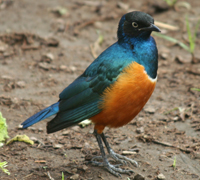
Superb Starling
Just as common as his northern cousin but a waaay snappier dresser.
Rachel: In case you were wondering, Rachel had a cold, blocking her nose. Breathing through her mouth, her tongue became sticky and when she swallowed it got stuck to the roof of her mouth. I finally figured this out when I stuck my pinkie in her mouth to see if I could feel any obstruction. This released the suction and she immediately began to breath again. She never even woke up. I couldn't sleep.
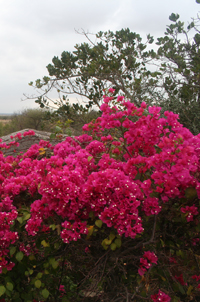
Bougainvillea
In its natural habitat.

Wattled Starling
Put to shame by his African cousin, drab even by European standards.
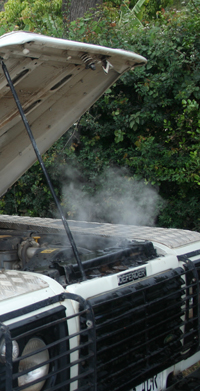
It's a Land Rover...
What could possibly go wrong? Who knows, but with four in the fleet, and at least a couple of hours on the road, the chances of all of them reaching the destination is zero. We were not disappointed.
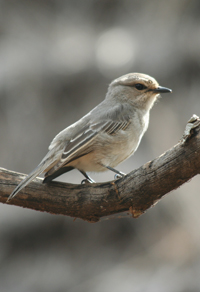
African Grey Flycatcher
Yes it is. Wayne says so.
Mini-Safari mammal hit list more-or-less in order of appearance:
Giraffe
Ostrich (ok, not a mammal)
Bushbuck
Mamba (also not a mammal)
Impala
Zebra
Wildebeast
Eland
Elephant (mammal but followed by homo sapiens with a stick, so does not count either)
Hare
Red-necked Francolin (big bird)
Blue Monkey (not to be confused with the Black-faced Monkey, affectionately known in the team as the blue-balled monkey, for startlingly obvious reasons but which was on the Serengeti, not here)
Aardvark (I wish. Its hole only)
Greater Bushbaby
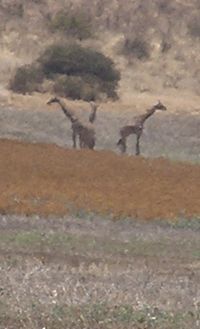
Giraffe
A long way away, but the silhouette is unmistakable.
Photo courtesy and
Copyright © 2010 Wayne R Munns
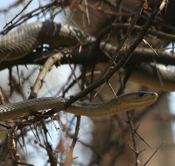
Mamba? What color?
The guides, looking at the camera preview said "green mamba." Scary. But all the interweb sites I've used to try to confirm this show a much brighter color. "Grass green" is a common description. The trouble is, it looks like a mamba. And the only thing that looks like a mamba but which is much darker than a green mamba is a black mamba. Very scary. One of the top ten deadliest snakes in the world, much respected for its aggression and the ferocity of its attacks (one of the few that strike repeatedly).

Shower unit
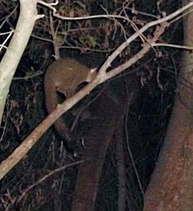
Greater Bushbaby
On his way down for a treat (chopped fruit put out on the banister by the bar man).
Photo courtesy and
Copyright © 2010 Mick Lemmerman
But I digress: back to the briefing
"There will be three assistant guides: Wilson Faraji, Kelvin Assay and Sunday Kapange. We will also have 45 porters." Yikes. Andrew told us about the route, advised us on what equipment and clothing we would need, and handed out the rental equipment folks had signed up for. His no-nonsense approach was calming except where he listed things that I had neither brought nor rented, when he had the opposite effect—it scared me. No duvet jacket, no glove liners, no snow glasses. I had visions of being sent down the mountain like a guilty schoolboy if/when he discovered I was underequiped. I took him aside and explained my situation. He seemed most concerned about the glasses. I told him I had my cycling glasses, which sort-of wrap around my face and that was that.
We introduced ourselves:
- RT—Yours truly
- Wayne Munns—My brother-in-law, brother-in-arms, brother
- Mick Lemmerman—My long-time buddy from The Netherlands
- Brian Gourlie—My squash buddy
- Steve Ippolito—My squash buddy's buddy (collectively all the above known as "the-five-do-kilimanjaro")
- Doug Day—"Chicago Doug" henceforth referred to as CHI-D
- Doug Jossem—"New York Doug" henceforth referred to as NYC-D
- Stacy Beakess—father of Spencer, buddy of CHI-D and Nick Taube
- Spencer Beakess—son of Stacy, break dancer, sole rep of next (current?) generation
- Nick "Real Man Coming Through" Taube—lion heart, buddy of CHI-D and Stacy,
- Paul Andrews—Or at least that's the name he gave us, not the one on his passport
No other excitements. We go over the itinerary in some detail, we ask a bunch of questions too dull for me to recall never mind recount, and then it’s time to repack our bags and present ourselves at the lodge entrance for transportation. Finally we will escape from the airport. Not a bad airport in which to be imprisoned, I’ll grant, but I can’t wait to get out into the country.
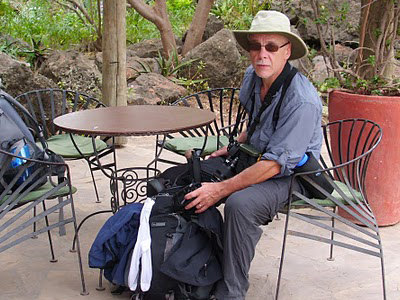 Photo courtesy and
Copyright © 2010 Mick Lemmerman
Photo courtesy and
Copyright © 2010 Mick Lemmerman
We had about fifteen minutes to complete our (re)packing, and then be ready to load the Land Rovers. So 30 minutes later everyone had identified their bag, confirmed that it had been thrown on the roof or crammed in the back of one of the vehicles, and had found a seat somewhere. Well, nearly everyone. Andrew has done a head count and he's missing two people. He pokes his head into each vehicle and asks who is missing. Ours is last, so I take a wild stab in the dark: "Are Brian and Steve here?" He goes back with the names. No they are not. It takes a few minutes for them to hove into view, and they and their bags are unceremoniously bundled in, amid loud cat-calling from all the vehicles. We're off.
It felt good to be on the road, and finally start to see something of the country. After Ghana we were not surprised at how many people we passed, walking from who knows whence to who knows where. Actually it was Sunday, and many were clearly in their Sunday best, so church was definitely at one end or the other.
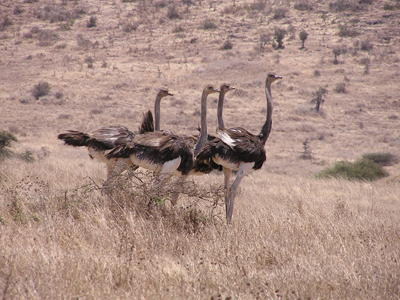 Photo courtesy and Copyright © 2010 Wayne R Munns
Photo courtesy and Copyright © 2010 Wayne R Munns
Paul’s luggage had not arrived, so we stopped at a strip mall to buy him some plastic bags to put his rented equipment in, and soon we are out into open country. Savannah. And to our surprise, we start bagging our first wildlife: in the far distance, the distinctive high-back chair silhouettes of giraffe, and much closer to the road, a gaggle of ostrich (young bachelors).
Sad to say I was not surprised when we have to pull over because one of the Land Rover's blew a gasket (literally) or at least something of that ilk because steam was billowing from under the hood. Small children appeared from a nearby house and started plying back and forth with containers of water. Steve wandered up the road and started a conversation with another local. He is highly skilled at holding forth with folks when they have no language in common. I tried to capture the event, but of course his new friend wanted money for the privilege. Thanks but no thanks. In the end we had to leave the Land Rover there, cram everyone in the remaining options and come back later for the luggage!
Ndarakwai Lodge
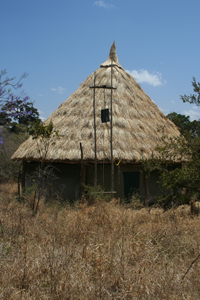 Again, the setup was quaint cottages scattered amongst the trees, and the communal buildings the same. So the reception area was its own open walled building, and from there we were dispatched to our rooms, which this time were thatched-roofed tents. If you could called them tents. They were even more luxuriously appointed than the airport lodge. Naturally ours was the furthest away, but that puts us at the edge of the complex, which suited us fine.
Again, the setup was quaint cottages scattered amongst the trees, and the communal buildings the same. So the reception area was its own open walled building, and from there we were dispatched to our rooms, which this time were thatched-roofed tents. If you could called them tents. They were even more luxuriously appointed than the airport lodge. Naturally ours was the furthest away, but that puts us at the edge of the complex, which suited us fine.
Need a shower? Stroll down to reception, give them the news, return home. A little while later there's a rustling outside the tent, and about ten gallons of hot water poured into a bag mounted on a flag pole outside each tent. Hoisted to the top of the pole for pressure, there's a call to let you know that you are ready. But you've already leapt into the shower fully clothed because the previous occupant did not close the valve, and your precious water is escaping down the drain.
And as usual, there’s no time to dally. Throw the bags in the room, grab the bins, and head back out for a bird-watching lunch.
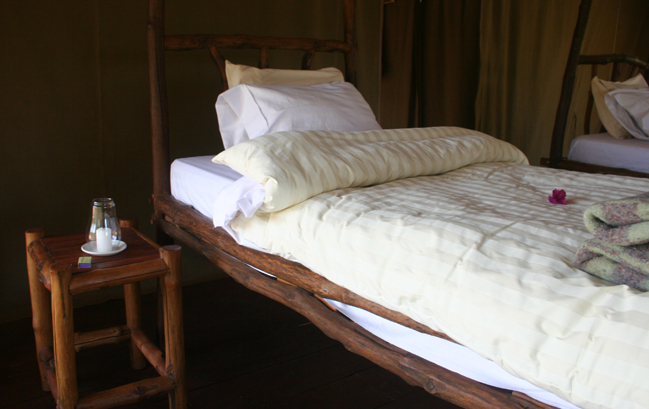 I didn’t take the camera and missed a gaggle of mousebirds squabbling over a cluster of fruit high up in a tree by the mess hall, but by the time Wayne spotted the mamba in a tree by the workers compound I had rectified the error. No sign of the mousebirds by then, naturally.
I didn’t take the camera and missed a gaggle of mousebirds squabbling over a cluster of fruit high up in a tree by the mess hall, but by the time Wayne spotted the mamba in a tree by the workers compound I had rectified the error. No sign of the mousebirds by then, naturally.
The snake caused a flurry of excitement, both for the birds who had initially brought it to Wayne’s attention and for us, as it was the first live specimen we’d seen despite two previous trips to snake country. It was safely behind a fence through which we stared for a long time as it maneuvered along the tree branch, so it was not nearly as scary as it might have been (or as the pictures imply), but it was nevertheless chilling to show the guides the preview on the camera back and for them to proclaim it to be a green mamba. Even more chilling to get home and find that the evidence seems pretty overwhelming that in fact it was not a green mamba and instead was black, the sixth most deadly snake in the world.
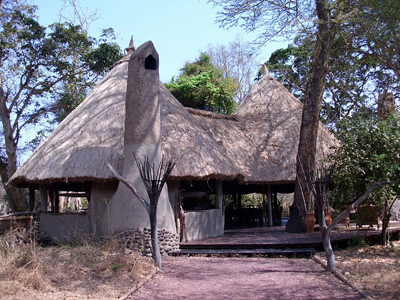 Photo courtesy and
Copyright © 2010 Mick Lemmerman
Photo courtesy and
Copyright © 2010 Mick Lemmerman
Lunch was spectacular, salads, stews, curries, fruits, and other desserts. Then the staff announced that for those who felt like a stroll, they would have a guide take us out into the savannah to see what we could see. None of us had any great expectations, but the exercise and chance to explore were too good to miss, so about half of us trailed off behind him. He's carrying a pop-gun over his shoulder. Wow. That'll be a big help, unless he plans to turn it around and club the attacker with the stock. I’m so sorry Mick was not one of the party, since he was the only one of the five not going on safari, and this walk really did turn into a safari, much to our surprise, and delight.
If only we could see it, it would also provide a spectacular view of the mountain. Instead it was just a spectacular view of one of my favorite trees: the jacaranda.
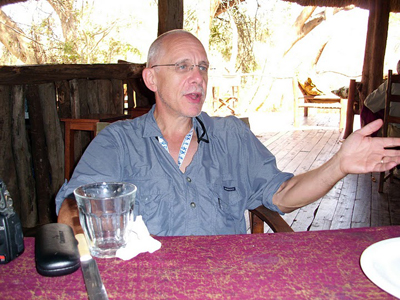
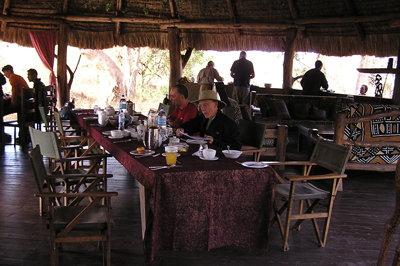
Photo courtesy and
Copyright © 2010 Mick Lemmerman ![]() Photo courtesy and Copyright © 2010 Wayne R Munns
Photo courtesy and Copyright © 2010 Wayne R Munns
This was a great opportunity to try out my new bins, which were awesome. The image stabilizing not only cures sea-sickness, but seemed to help pick out detail so things actually seem sharper.
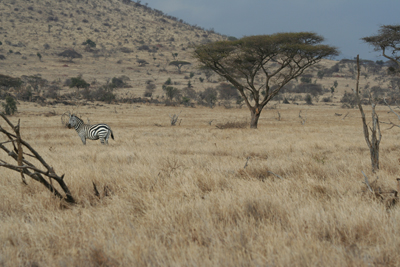 Someone pointed to some fruit about 40 feet up a tree and poses "Is that apples or bananas?" I found the question hilarious on a number of different counts, but anyway the bins soon put the matter to rest: "figs." To which the response was "That was my first thought too."
Someone pointed to some fruit about 40 feet up a tree and poses "Is that apples or bananas?" I found the question hilarious on a number of different counts, but anyway the bins soon put the matter to rest: "figs." To which the response was "That was my first thought too."
Of course the glass was superb for the wildlife too, and I resolved that I needed to register stuff in the clear three-dimensional world of the binoculars first, then, if there was time, try to capture the image on film. And that is my excuse for missing so many good shots this trip.
There are plenty of herbivores to see, but as usual even with the bins I need to have the location pointed out to me about six times by three different people before I make out the elands, which are the size of cows. Well, they were a long way away!
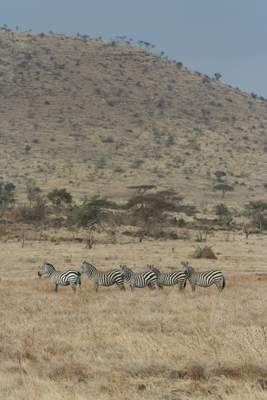 We'll not dwell on the wildlife. That can wait for the safari. But one incident does stand out.
We'll not dwell on the wildlife. That can wait for the safari. But one incident does stand out.
The only giraffe we saw during the walking safari, and our first one up close, was dead. Without doubt this was the largest carcass I had ever seen, and it was a sobering amount of deadness.
The guide was fairly confident that he had not been taken down by predators because he had been young (but pretty much full-grown), he was healthy (apart from being dead) and there was no sign of being attacked. Male giraffes spar using their necks and there is something about the twisting motion this generates that can sometimes pierce the heart, which was the guide's best guess for what happened here.
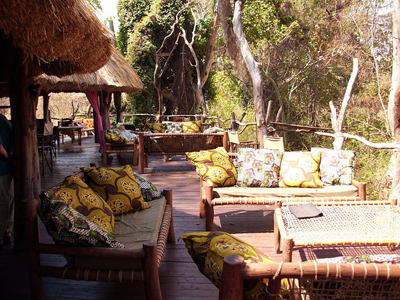 Photo courtesy and Copyright © 2010 Mick Lemmerman
Photo courtesy and Copyright © 2010 Mick Lemmerman
In the evening after dinner a bunch of us retired to the "lounge" while others went back to their packing and repacking. Once it was completely dark, the bushbabys came out, and the barman encouraged them down to eye-level by putting chopped fruit out on the railing.
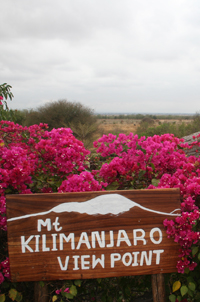
Ha ha ha
And this was the best view we had, until we were half way up the side.

Scarlet-chested Sunbird
Naturally his fluorescent red waistcoat is hidden behind the only other red object within a thousand pixels.
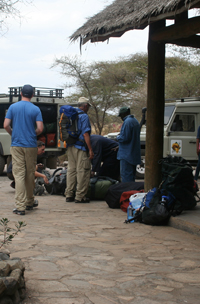
Land Rovers, lads, luggage
Preparing for take off. Everyone has to identify their bag and verify that it is somewhere in, or on, one of the vehicles. Nick (center) gets processed while NYC-D (left) looks on.
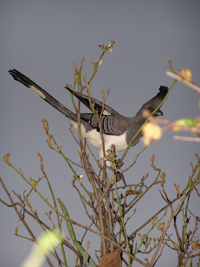
White-Bellied Go-Away-Bird
Wayne: "Related to the turaco in the rain forest." RT: "Who'd be a turaco if you could be a white-bellied go-away bird instead?"
Photo courtesy and
Copyright © 2010 Wayne R Munns
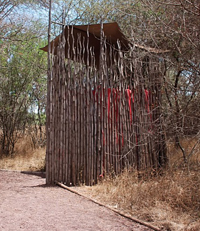
Ndarakwai long drop
Incongruously, once you negotiated the spiral entrance, there was a full-blown regular western-style flushing commode where there should have been a long drop. Who woulda thunk?
Photo courtesy and
Copyright © 2010 Bruce & Sheryl Kuo

Soap
No really.
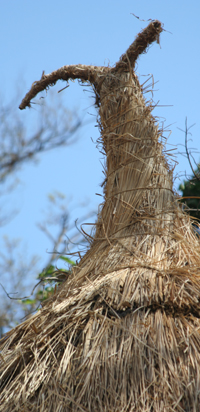
Thatch signature
Some roofs were finished with more aplomb than others.
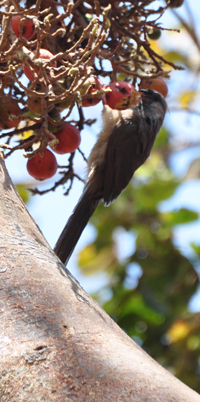
Mousebird
At least someone caught one of them
Photo courtesy and
Copyright © 2010 Doug Day
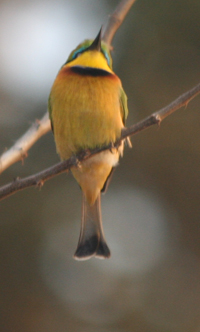
Little Bee-Eater
I think they must skewer their lunch.
Copyright © 2010 Richard Thomson

